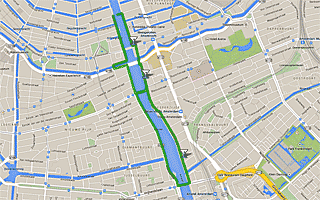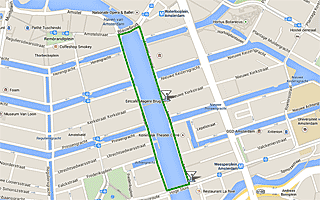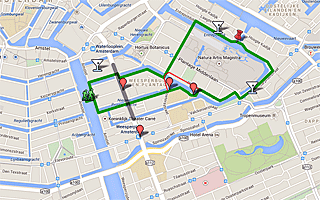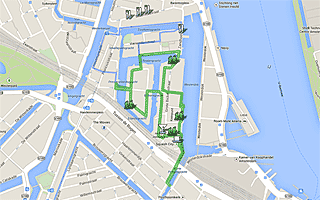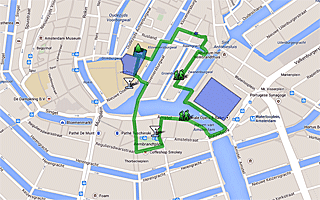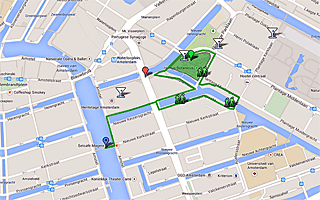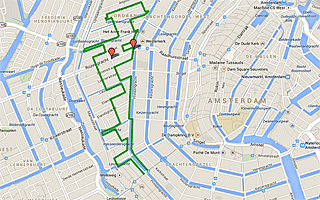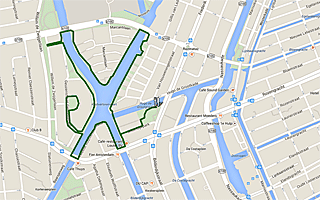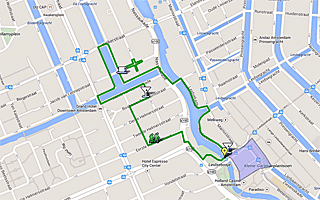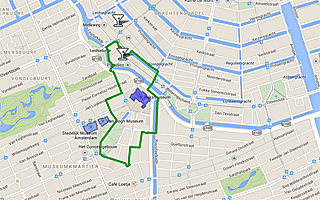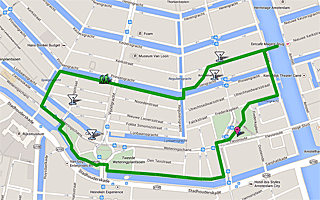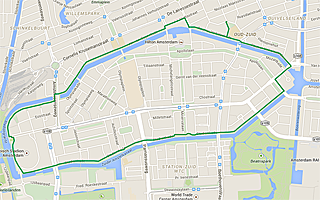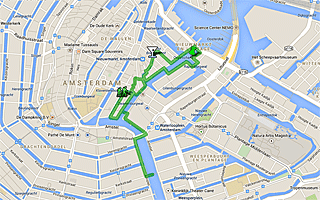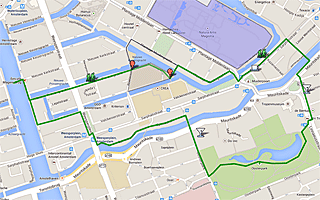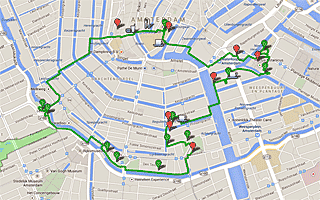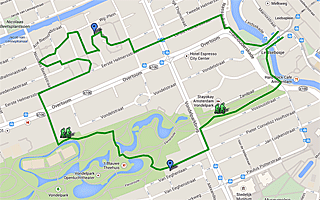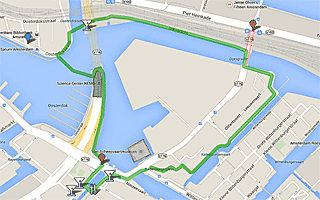Autumn Gold…

Autumn Gold in Amsterdam
Amsterdam basks in the last rays of the low autumnal sun and its inhabitants carry on as if it's still high summer. That's the Indian summer version of course; there's also the autumn when we get blown to bits or when the cold sets in early attacking us from the east. Or the city may be shrouded in fog lending it an enchanting Venetian atmosphere.
Whichever the scenario, if you've done one of our walks, you'll have earned that drink in one of our carefully chosen ‘inns’, cheers! slainte, proost, chin chin…
Autumn walks in Amsterdam
-
Amstel River along the Weesperzijde Walk
The Amstel River is as much the essence of Amsterdam as the canals are, and no self-respecting tourist can return home without having had a stroll along the banks of the Amstel. This is a longer walk of 3 miles (5 km or so) but you can cut it a lot shorter by traversing one of the bridges, at Ceintuurbaan for instance.
However, if you do go the long haul, and walk as far as the Berlagebrug (bridge), you will not regret it. It takes you southwards, along the Amstel River, right on the riverside. On your way back, seeing the central city in the distance, you will get some idea of how Amsterdam appeared from afar in bygone days.
-
Amstel River and Reguliersgracht Walk
Lots to see on this short, round-trip walk, which is stunning on a beautiful morning or evening. During the day it is lovely too but it is more noisy and busy and this spoils its surprising city centre serenity. You can start on the Skinny Bridge (Magere Brug) and then follow the Amstel in a southerly direction. After that, the walk takes you through the Frederiksplein and Falckstraat, both of which are green oases.
This walk is very short and central yet gets you away from ‘the madding crowd’. It is easy to do in the evening and because you'll encounter umpteen bridges with their lovely lights, it's great after dark too.
-
Amstel River Short Walk
A lovely riverside walk in the heart of the city. Despite the short distance, it includes the essence of the city: canals, Theatre Carré, the Hermitage Museum, the upmarket Amstel Hotel, the Skinny Bridge (Magere Brug), the Stopera, and you'll cross the Prinsengracht, Keizersgracht and Herengracht on your way and may glimpse the towers of the Rijksmuseum. It's only about a mile so should take no more than 30 minutes, however, being such a picturesque walk, you may be tempted to dawdle and gaze at the nice vistas.
-
Artis Area and Entrepotdok Walk
A wonderful walk, it's not long, only a few miles / kilometres. The many weeping willows along the water are lovely. You can do this walk morning, noon or afternoon / evening, as long as it's still good and bright. There are some mighty poplars too along the way, two separate stands.
-
Bickerseiland, Prinseneiland, and Realeneiland Walk
Called the ‘Western Islands’ district, this area is made up of three islands of land joined by little bridges. Some parts are very quaint, whereas other stretches face dramatic vistas of modern dockland development, mostly business and residential. All in all, this area is pleasantly secluded, being a kind of cul-de-sac, and on a nice warm day you'll feel the benefit of being surrounded by water.
-
Brouwersgracht, Langestraat, and Herenmarkt Walk
When I think of autumn I see the Brouwersgracht. There's no objective reason for this but this walk does give autumn the pedestal it deserves. It's being able to hug the canal for such lovely long stretches and the cosy feel of the little streets that intersect with the canals. It's lovely on a golden September day but equally enjoyable on a sodden and blustery October evening.
-
City Hall, Stopera, Zuiderkerk, and University area Walk
Right in Amsterdam's city centre, this short walk of less than 1.5 miles will amaze you by its tranquillity. Although you're just a stone's throw from ‘the action’ you'll feel as if you're in a little village at times. Vary the route according to your mood and energy.
-
Hortus Botanicus (Botanic Garden) and surrounding area
This area is called the Plantage which translated means plantation, so I don't need to elaborate on the leafiness. But I will ha ha! Was there ever a small city district so beautifully planted with trees of such considerable age, variety, shade and texture! You'll find plane, lime, beech, elm, cypress, willow, poplar, birch, to mention but a few. Tree experts should love this area because there are lots of rare and mature specimens.
-
Jordaan South Walk
With street names like Roses Street (Rozenstraat), Eglantine Street (Egelantierstraat), Flower Canal (Bloemgracht), it should be no surprise that this area is blooming. The Jordaan is an area of little canals and streets, little bridges, little houses; everything here has big ‘cute’ appeal. In the morning or evening, it has a restful atmosphere, especially during the weekend.
-
Kostverlorenvaart Walk
This curiously shaped route (see map) represents a lovely walk beside water and trees in the west of Amsterdam. It's almost totally on a traffic-free footpath which gives it its special appeal and you should find it an utterly relaxing experience. You can start somewhere central in the city and walk to the Bilderdijkpark or you can take a tram. This route is only about 10 - 15 minutes on foot from the Jordaan, so it's quite near.
-
Leidse Loop
The bustling Leidseplein can be a pleasant oasis on a nice spring morning. This ‘Leidse Loop’ walk is a mixture of leafy canals and semi-pedestrian streets full of art for the interested passer-by. There's lots to see and enjoy on this walk that loops the Leidseplein.
-
Leidsekade to Da Costakade and back Walk
Take the Leidsekade (quayside) just around the corner from the hubbub of the Leidseplein, start by the American Hotel. Wander along the Leidse, van Lennep, and Da Costa quaysides; nose around in cute residential areas. You're never more than about 15 mins from the Leidseplein and yet you'll feel pleasantly ‘away from it all’. Although not called canals, these quayside ‘kade’ walks are every bit as nice, just not quite so old as the 400-year old canal ring.
-
Maritime Museum and Oosterkerk Walk
Lovely, leafy, waterside walk when you feel like something completely different. Despite being the old shipyard area and housing for the shipyard workers, this area is mainly recent residential architecture. Most of the old buildings were knocked down to make way for modern housing but it still feels authentic and it has been nicely planted with trees of all sorts.
-
Museum Route
A good route because you get to see a lot of the museums in a panorama and from a distance. The Rijksmuseum is wonderful but from Museumplein you can also see the Concertgebouw, the Stedelijk Museum and the van Gogh Museum. Nice too in winter because this walk is nice and spacious and so you get great vistas. Only about 1.5 miles so a doddle really.
Luckily the ‘Rijks’ is open again after a 10-year renovation, and I sincerely hope that all the building pre-fabs and other eyesores around the site will disappear soon. -
Nicolaas Witsenkade to Rijksmuseum Walk
Another lovely spring walk especially if the plane trees have come into leaf. The first part mainly plane trees but after that, from the Wetering Circuit onwards, you get a lovely sweep of weeping willow weeping away into the water. This part has a great backdrop with the Rijksmuseum behind, magnifique.
-
Olympic Stadium Loop Walk
Lengthy and peaceful waterside walk past a great variety of architecture.
During this walk you’ll explore a less-known area just at the edge of the centre where it’s quiet and spacious – wonderful on warm weekends when the city pavements can be thronged with (other) tourists. On this waterside loop you can walk at leisure, find a bench to sit, read, or dream, while enjoying lovely trees, pavement gardens, and interesting architecture along the way. This route goes around the Olympic Stadium, and the round-trip continues beside the water on the way back towards the city centre. You’ll be beside water most of the time and it’s relatively traffic-free and blissfully so in places.
-
Oosterpark, Eastern Islands, and the Kadijken Walk
Roam along leafy waterfronts, take your time in the beautiful Oosterpark, and admire the majestic Tropeninstituut (Institute & Museum of the Tropics) which you'll spot from a distance and can gaze at from many angles. Further along, the old eastern-island harbour area has a mix of wonderful old warehouse buildings and modern constructions, not all to ones taste, but interesting nonetheless. It's a great walking-area with few cars, some nice green areas and water, water, everywhere.
-
Oudeschans and Kromboomsloot area
Nice about this walk is that you can shorten it or just go with the flow and complete the few miles/kilometres. The route takes you along the Amstel, past the Opera City Hall and then down to the oldest area of the city. You'll see lovely old towers, the modern Nemo Science Museum (built like a ship) in the harbour and lots of typical Amsterdam facades and lovely canals along the way.
-
Oudeschans and Nieuwmarkt area walk
This walk and neighbourhood is a breath of tranquility sandwiched as it is between the hectic Nieuwmarkt square and the Waterlooplein Fleamarket. You'll be surprised and relieved to discover the peace and quiet immediately on leaving the busy streets.
-
Plantage and Hortus Botanic Gardens Walk
Gorgeous green walk which you can start on the Amstel in the centre. Includes two small parks with great trees and the pavement gardens in this area are hard to beat.
-
Plantage, south of the Zoo, and Oosterpark Loop
This is a fairly satisfying walk which will take you out of the inner city, starting at the Amstel River by the Skinny Bridge. Going east, you will head towards the zoo beside canals and other waterways. Then you will go south and west taking you back through the Oosterpark (Eastern Park) which makes for a nice leafy loop, fantastic in autumn. The walk is 2-3 miles but there's lots to see both natural and cultural.
-
Trees of Amsterdam walk
Here's quite a leafy walk to acquaint you with some Amsterdam trees. There are too many interesting trees to include in one walk, but this will be a good intro. It's a substantial distance (4.6 miles/7.5 km) but you can cut it shorter if you've had enough.
-
Vondelpark and WG-terrein Walk
An uplifting spring walk if ever there was. Lots of welcome spring charm, daffodils, and cherry blossom. Am beginning to sound like Dana now but this walk really is wonderful on a sunny day. From the Leidseplein, you'll roam through the Helmer district and back via the Vondelpark. It's a walk of discovery leading you along interesting residential streets and through the ‘WG terrein’ which was once the site, both grounds and buildings, of the ‘Wilhemina Gasthuis’ (Hospital).
The following walks would be good too on a nice autumnal day
-
Docklands Dijksgracht Walk
Part of Amsterdam's beauty is that it's not all manicured and perfect. This walk is a great example of Amsterdam Raw – its ‘unclipped edges’. Peaceful and lush green for the most part, yet in the centre. You'll pass the Maritime Museum, ramble through dockland residential areas finding yourself in leafy bliss on waterside footpaths. The railway is ahead of you in the distance.
-
IJ harbour via Oranjesluizen (locks)
Not for the faint-hearted! This 15 km (10 mile) tramp will take you to remote places where you need both a good map and a reasonable sense of direction. Although the length of the walk is not hugely strenuous, this route is remarkably rural and remote for a city walk. You'd be well advised to have some emergency nutrition with you, and water if it's a warm day. There is quite a stretch where you won't meet either a shop nor a café.
What you can see in autumn in Amsterdam
Autumn Colour
Again it's the way the water and trees enhance each other; autumn highlights this golden harmony and the golden glow is everywhere, even on grey days. To use the image ‘rivers of gold’ is not an exaggeration.
The canals
The canals glisten and glitter, they shimmer, shine, and they sparkle. They glow and they gleam, they glint and they twinkle. The water is rarely mirror-still yet it reflects the colours, absorbs and radiates.
All these waterways become ever-changing abstract masterpieces reflecting not only the golden trees, but the wonderful autumnal skies, boats, waterside buildings and their colours.
Trees
If the wisteria is the big attraction in spring, and roses are the summer sensation, then it's the trees that really fascinate when autumn comes. The tree-lined streets, canals and quays turn to red, yellow, and gold. In the walks we will steer you towards some stunning tree-lined tributes to autumn, including wonderful arcs of plane trees, stands of poplar, oases of Caucasian wingnut, chestnut, ginkgo, lime and of course elm, all bathed in autumnal light and mostly in or near the centre of the city.
Evening glow
As evening falls (as it does early in the fall), the warm lamplight from curtain-less windows reflects the yellow gold of the trees. Walking home in the evening is autumnal bliss.
Vines and other fruits
Vines thrive in Amsterdam and as you walk around you will see how they also turn a golden hue in autumn and how their branches get heavy with bunches of grapes. Actually you may end up squelching around in fallen bunches as you pass by.
Recently, there are even apple and pear trees growing right in the city-centre.
Plant colour in pavement-gardens
There's usually plenty of residual colour, roses, hydrangea, lavender, potentilla, hollyhocks even wisteria should be adding some colour to the pavement-gardens around now. Apart from these, there are lots of annuals and perennials giving their last hurrah.
Probably the best of all are the sunflowers at this time of year.
